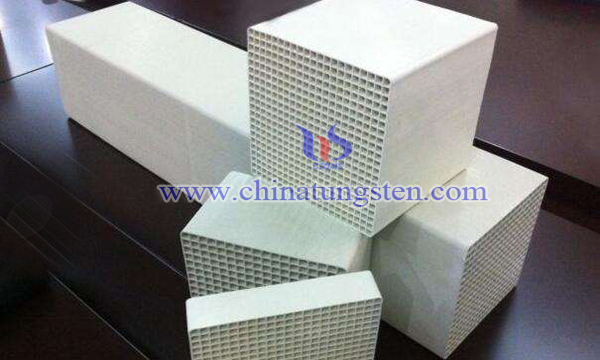Recovering Vanadium and Tungsten from Vanadium-Titanium-Based Waste Denitration Catalyst
- Details
- Category: Tungsten Information
- Published on Wednesday, 25 July 2018 17:54
Nitrogen oxides (NOx) are recognized as one of the major sources of atmospheric pollution, including combustion fumes and automobile exhaust. Monolithic vanadium-titanium-based catalysts have been widely used for the removal of NOx from combustion fumes or automobile exhaust, and NOx is removed by selectively catalyzing the reduction of NOx by NH3 to N2. The catalyst uses TiO2 as a carrier (usually 80-90% of the total mass), V2O5 as an active component (1-2%), and WO3 as a co-catalyst (5-10%).

The service life of vanadium-titanium-tungsten catalysts is usually about 3 years. In addition to the consumption of ammonia in the SCR operating costs, the cost of replacing the catalyst is mainly. Catalyst inactivation is divided into reversible poisoning inactivation and irreversible poisoning inactivation. The former can be regenerated by means of backflushing, ash removal, water washing, acid pickling and vanadium supplementation, so that the catalyst denitration rate can be restored to more than 90% of the original and reused, and the cost is 20-30% of the total replacement cost. However, a large number of SCR denitration catalysts are not regenerable or damaged during the regeneration process and need to be disposed of. It is expected that after 2018, China will save 78,000 tons of SCR catalyst per year. Direct disposal of SCR denitration catalysts not only causes environmental pollution, but also wastes rare metals such as vanadium and tungsten.
In order to solve this situation, some scholars have provided a method for recovering vanadium and tungsten from a vanadium-titanium-based waste denitration catalyst. The recovering process is as the following steps:
The vanadium-titanium-based waste denitration catalyst is crushed, grounded, and sieved to obtain a powder having a particle diameter of 100-120, and 5 wt% hydrogen peroxide is added to the catalyst powder, wherein the molar ratio of H2O2 to vanadium in the catalyst is 10:1, fully After stirring for 3 hours, a part of vanadium in the catalyst reacted with H2O2 to form pervanoic acid, and the filter cake (1) and the pervanadate filtrate (1) containing hydrogen peroxide were filtered. Adding H2SO4 to the filtrate (1) to adjust its pH to 4.0, then heating to 70 ° C, decomposing the pervanadate to V 2 O 5 at a constant temperature for a certain period of time, filtering to obtain a V 2 O 5 precipitate and a filtrate ( 2 ), and mixing the filtrate ( 2 ) with hydrogen peroxide use. To the filter cake (1), a 10 wt% KOH solution was added, wherein the solid-liquid ratio was 1 g/1 ml, heated to 100 ° C, and the reaction was stirred under constant temperature for 0.5 hour, followed by filtration to obtain a mixed solution containing NaVO 3 and Na 2 WO 4 . The pH of the mixed solution was adjusted to 8 with a sulfuric acid solution, and then NH4Cl solution was added to control the molar ratio of V:NH4 + to 1:4. After stirring for a certain period of time, the precipitate was allowed to stand, and the NH4VO3 and the filtrate (3) were filtered to obtain a filtrate ( 3) The concentrated sulfuric acid is added, and the molar ratio of W:H+ is controlled to 1:4. After stirring for a certain period of time, the mixture is allowed to stand, the tungstic acid is precipitated, and solid tungstic acid is obtained by filtration, and tungstic acid is calcined at 210 ° C to obtain WO3.
The recovery rate of vanadium is 93% and the recovery rate of tungsten is 84%. The process is simple, with high recovery rate, energy saving, environmental protection, low production cost, and has a wide range of application prospects.
- Tungsten Manufacturer & Supplier, Chinatungsten Online: www.chinatungsten.com
- Tungsten News & Prices of China Tungsten Industry Association: www.ctia.com.cn
- Molybdenum News & Price: news.molybdenum.com.cn
- Tel.: 86 592 5129696; Fax: 86 592 5129797; Email: sales@chinatungsten.com



 sales@chinatungsten.com
sales@chinatungsten.com